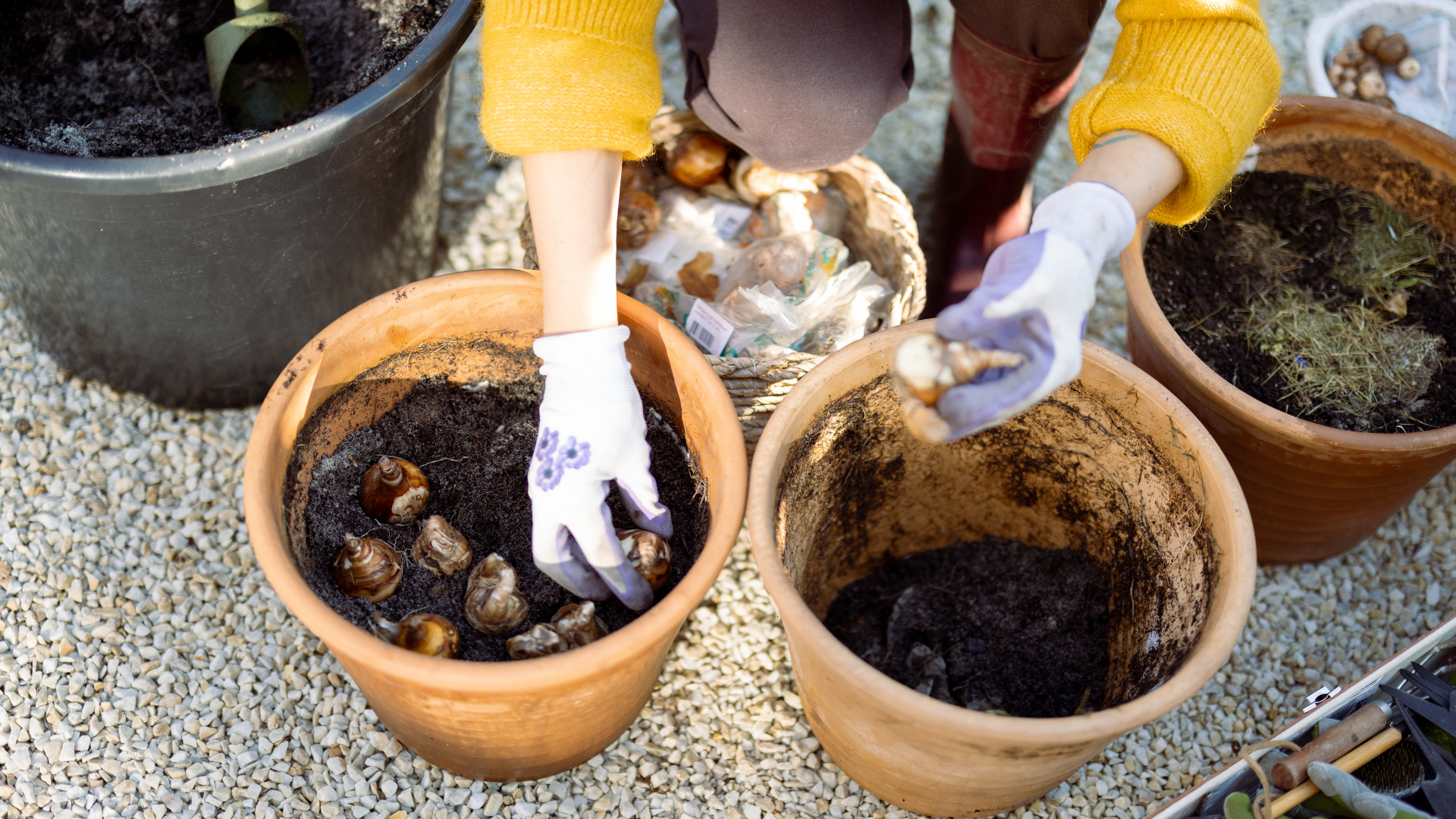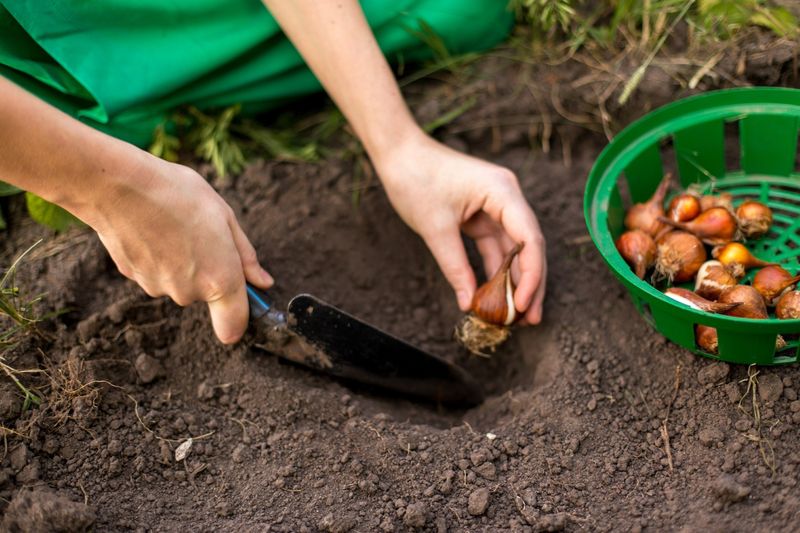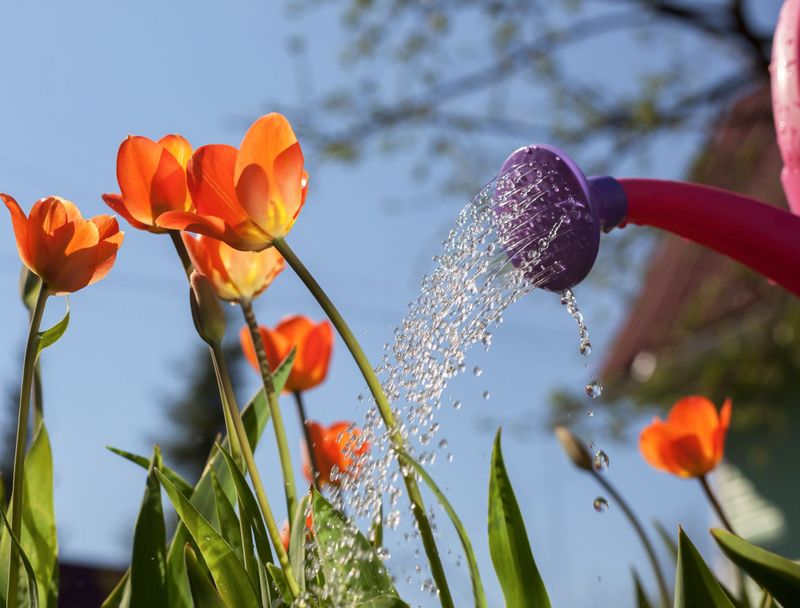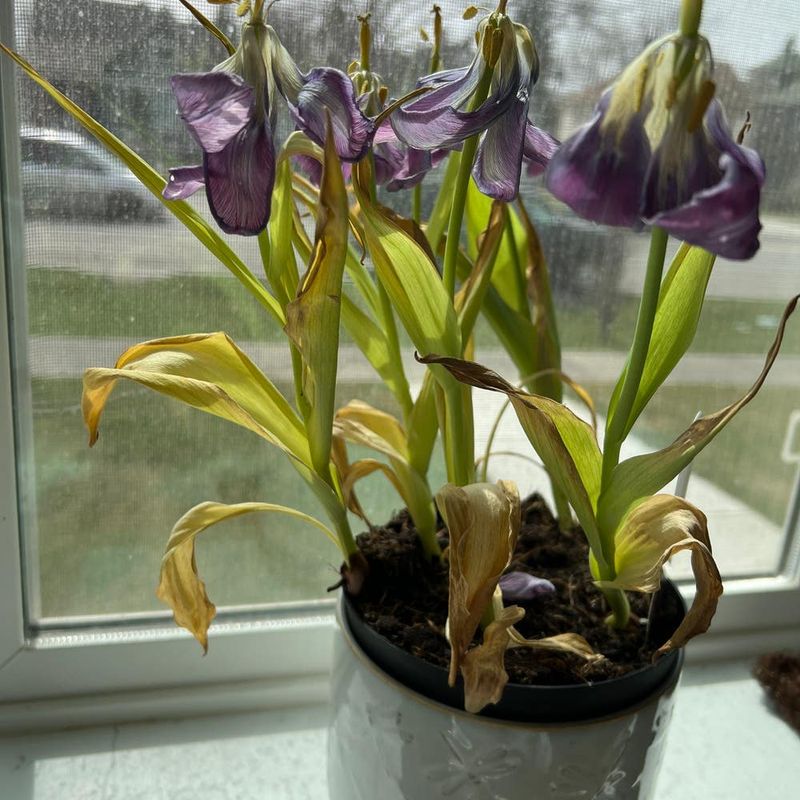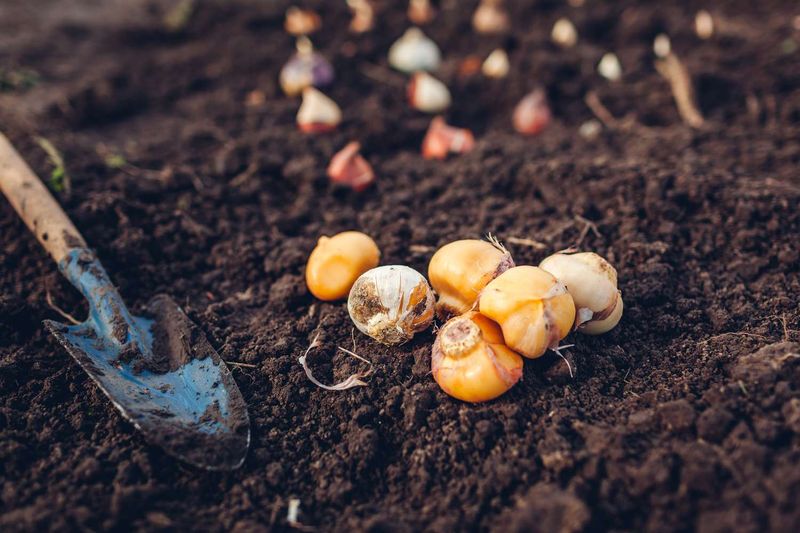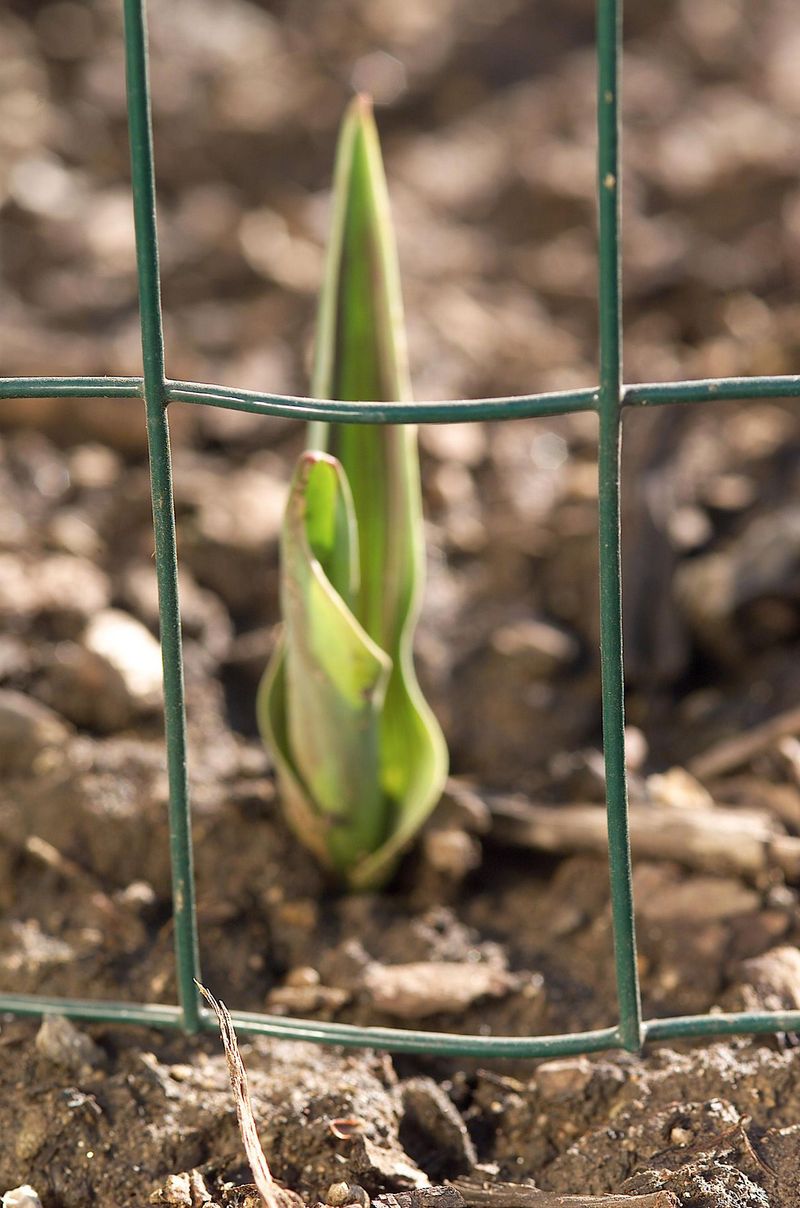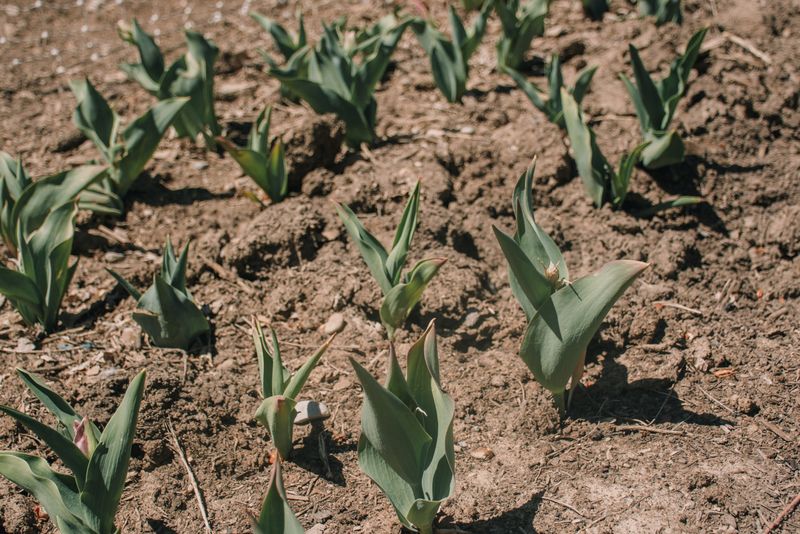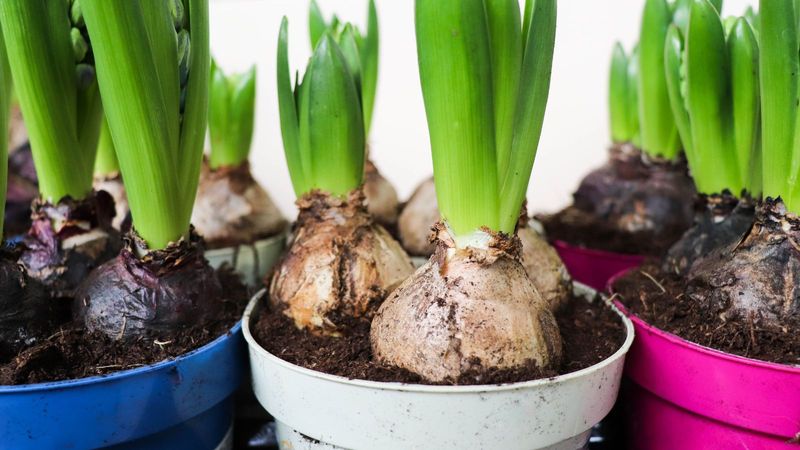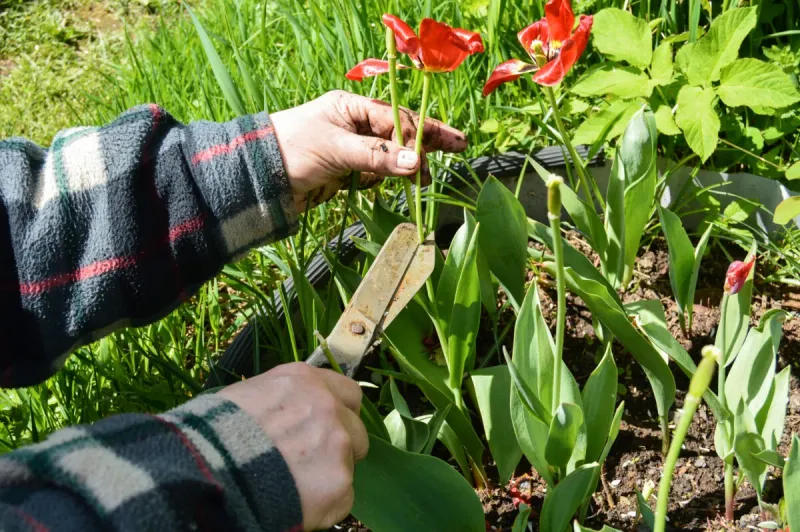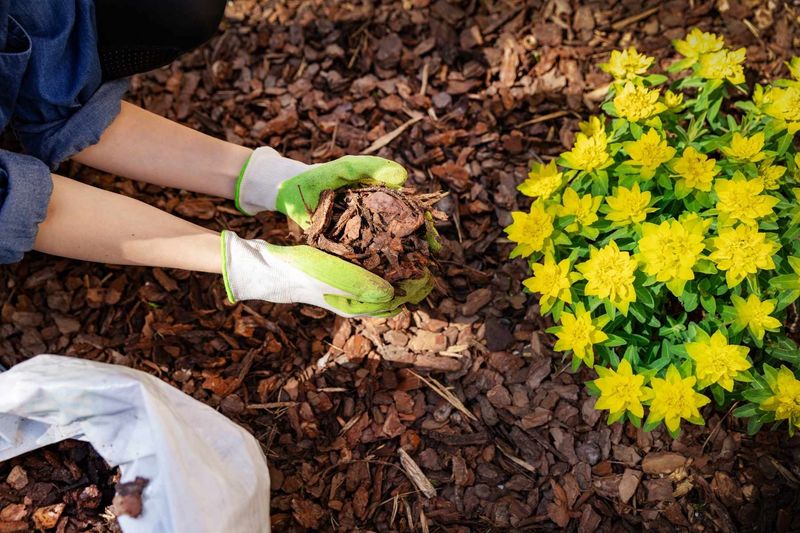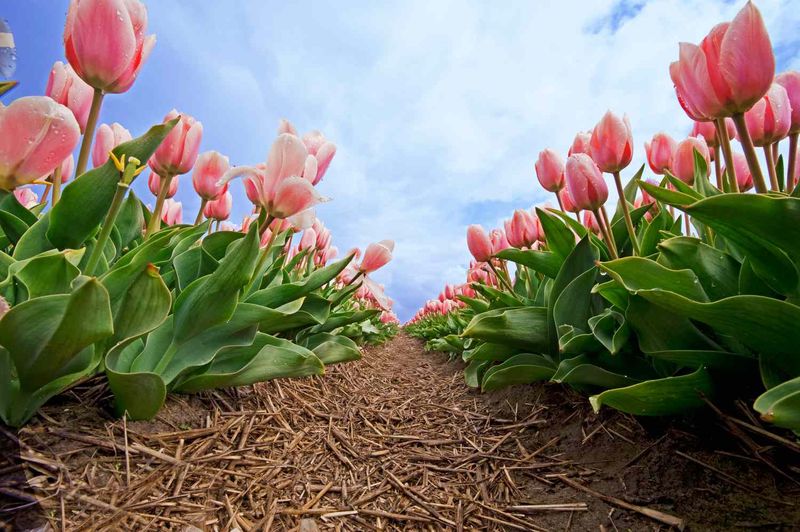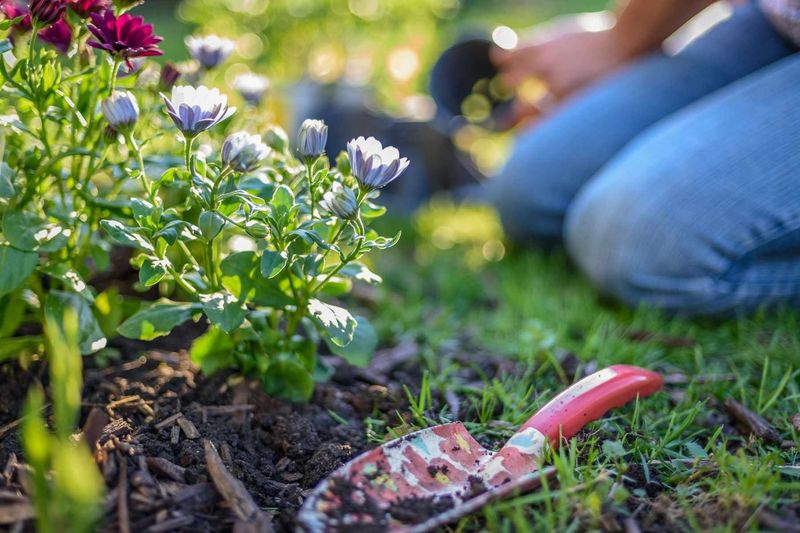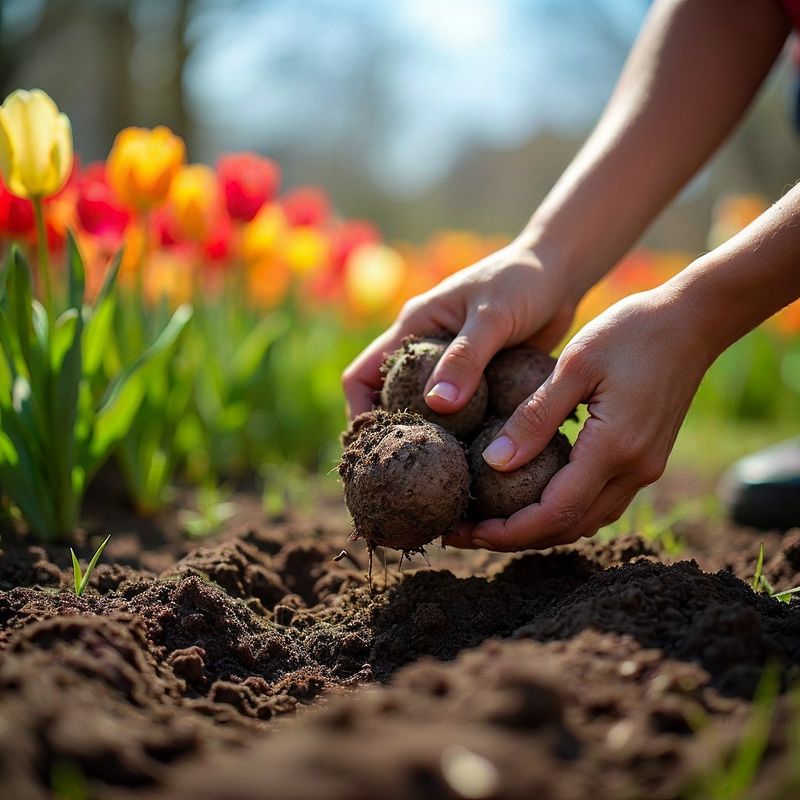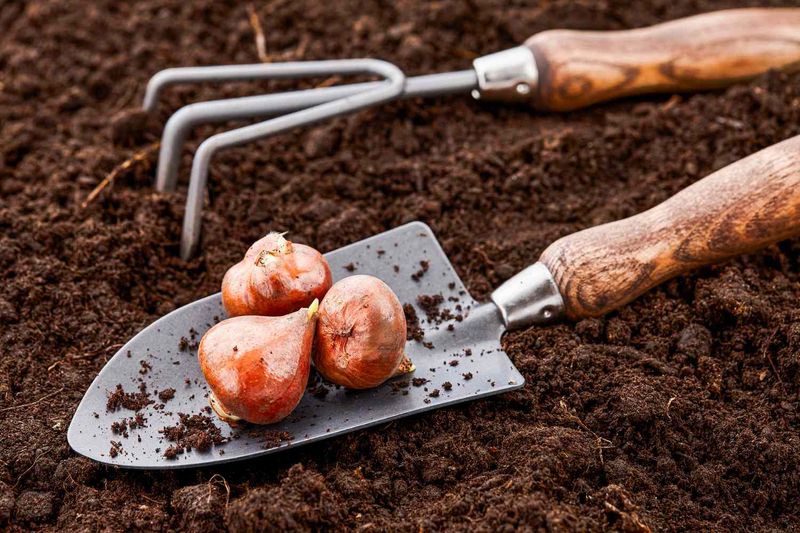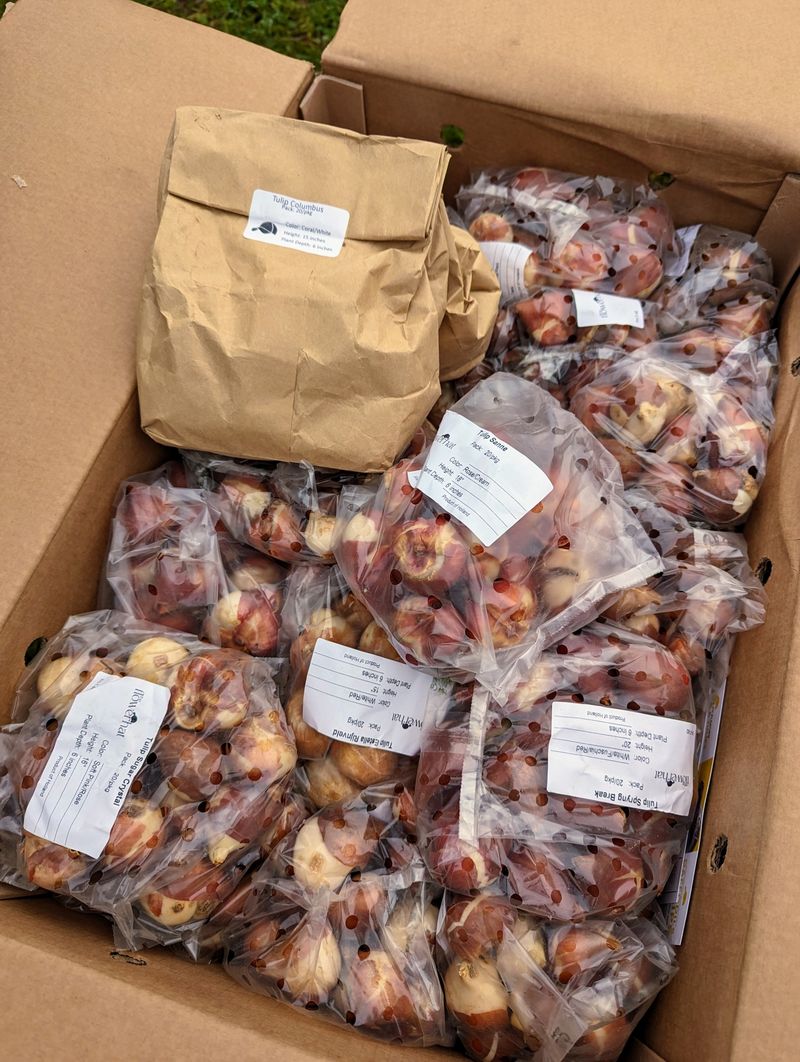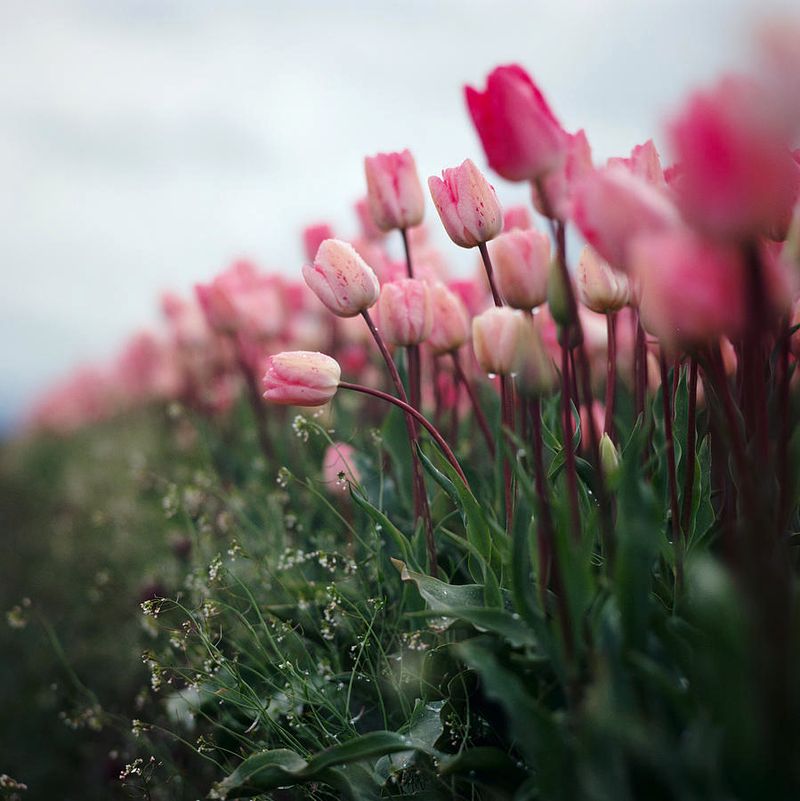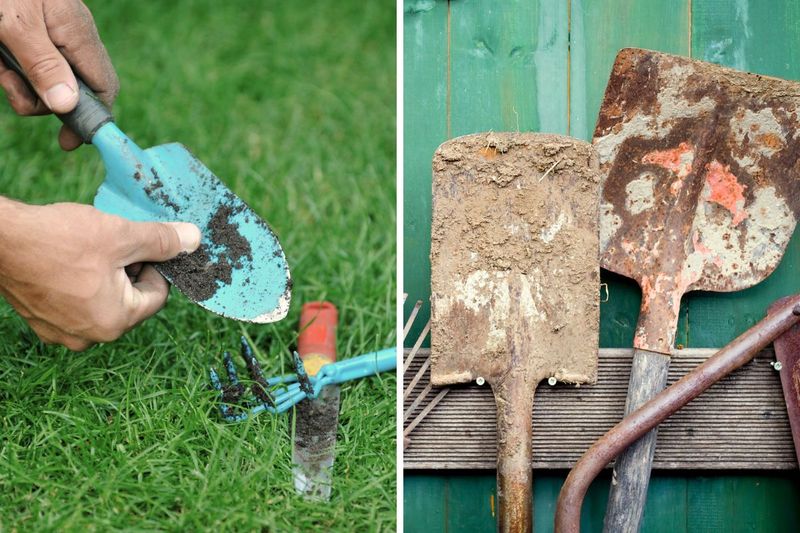I’ve always had a soft spot for those delightful spring bloomers that pop up like little surprises in the garden, but my first attempt at growing them was a comedy of errors.
From planting them upside down to forgetting to water them entirely, I made every mistake in the book before finally getting the hang of it.
Let me save you some trouble with this list of common pitfalls and how you can avoid them. Trust me, you’ll be chuckling at your own garden blunders soon enough!
1. Planting Too Deep
Burying bulbs too deeply might seem like a good idea to protect them from the cold, but it’s a recipe for disaster. Tulips need to be close enough to the surface to feel the sun’s warmth.
When you plant those bulbs, make sure they’re not more than six inches deep. If they’re too deep, they might not sprout at all.
You’ll find yourself looking at an empty patch of earth, wondering what went wrong. It’s an easy mistake to fix, just dig them up and try again!
2. Overwatering
I totally relate! When I first planted tulips, I was so eager to water them that I ended up overdoing it. The soil stayed soggy, and the leaves started turning yellow instead of flourishing.
After some research, I learned the importance of well-drained soil and adjusting watering based on the weather.
Now, I only water when the soil feels dry, and I trust the rain to do its part. My tulips are healthier than ever, and it’s a reminder that sometimes a little restraint can make all the difference!
3. Ignoring Sunlight Needs
Shady spots might seem like a cozy spot for flowers, but these particular bulbs crave the sun. Neglecting their light needs will lead to weak, floppy plants that struggle to bloom.
Look for a sunny spot in your garden where these beauties can bask in full glory. If you’re unsure, spend a day observing where the sun hits your garden.
Once you’ve found the perfect spot, you’ll see your efforts rewarded with healthy blooms. It’s a simple change with a big payoff!
4. Poor Soil Preparation
Skipping soil prep is like building a house without a foundation. Tulips need loose, nutrient-rich soil to stretch their roots. Without it, you’ll notice stunted growth and lackluster blooms.
Take the time to work in some compost or organic material before planting. It’ll pay off in the long run with healthier plants.
The extra effort might seem like a chore, but when those blooms peek through, you’ll know it was worth it. Your garden will thank you for the love and attention!
5. Planting Too Early
Getting a head start on your garden might seem exciting, but plant too soon, and you could be setting yourself up for failure.
These bulbs require a cooling period before they can sprout. Plant them too early, and they might think it’s spring already, leading to premature growth and frost damage.
Wait until the right time, usually late fall, to give them the best start. It might be hard to hold back your enthusiasm, but patience is a virtue, and your garden will blossom beautifully.
6. Not Fertilizing
Feeding your plants is as crucial as feeding yourself. Without the right nutrients, tulips can’t reach their full potential. If your blooms are looking a bit lackluster, they might be hungry.
A balanced fertilizer once a year can make all the difference. Apply it in the fall or early spring, and your garden will reward you with vibrant colors.
Don’t let your flowers go hungry; a little nourishment goes a long way. It’s one of those small steps that leads to big rewards.
7. Crowded Planting
Cramping flowers together might look appealing at first, but overcrowding leads to competition for resources. Each bulb needs space to grow, so give them room to breathe.
If they can’t spread their roots, they’ll be weak and spindly. Space them properly, and you’ll have healthier blooms.
It might be tempting to pack them in, but resist the urge. Your garden will be more impressive with a little breathing room. It’s a classic mistake that’s easily avoided with a bit of planning.
8. Ignoring Pests
Garden pests are like uninvited guests, and ignoring them won’t make them go away. Keep an eye out for signs of trouble like chewed leaves or stunted growth.
A few nibbles might not seem like a big deal, but pests can wreak havoc quickly. Regularly inspect your plants, and consider natural pest control methods.
By staying vigilant, you’ll keep your garden healthy and thriving. It’s a mistake that can sneak up on you, but with a little attention, you can keep those unwanted visitors at bay.
9. Forgetting to Deadhead
When I first planted tulips, I didn’t deadhead them, thinking I could just leave the old blooms be. But those spent flowers ended up draining the plant’s energy, and my garden didn’t look as fresh.
After reading up on it, I started snipping them off, and the difference was amazing. New blooms popped up faster, and my garden looked so much tidier.
It only takes a few minutes, but it’s totally worth it for the lively look it gives your flowers!
10. Using Heavy Mulch
Mulch can be a gardener’s best friend when used wisely, but too much of a good thing can be harmful. Heavy mulching can suffocate bulbs, blocking sunlight and air.
Choose a light mulch and apply it sparingly to protect without smothering. You’ll find that a gentle touch is all it takes to keep things cozy.
It’s one of those beginner mistakes that many make, thinking they’re offering extra protection. In reality, a little restraint is the key to letting those flowers flourish.
11. Ignoring Drainage
Standing water is a silent killer in gardens, and without proper drainage, your plants will suffer. Make sure your beds are well-drained to prevent root rot.
If you notice excess water pooling, it’s time to reevaluate your drainage system. You might need to amend the soil or adjust the slope.
A dry spell will do wonders for your tulips, letting them thrive. Neglecting drainage might seem like a minor oversight, but it can be a major hurdle in achieving a successful garden.
12. Not Rotating Crops
Sticking with one spot for your bulbs year after year is like eating the same meal daily. It leads to soil depletion and disease buildup.
Rotating your planting areas keeps the soil fresh and reduces the risk of illness. It might require a bit of planning and effort, but the results are worth it.
Your flowers will be healthier, and your garden will have a fresh look every season. Avoiding this common mistake will lead to a more diverse garden.
13. Ignoring Wildlife
Wildlife viewing your garden as a salad bar isn’t as charming as it sounds. Rabbits and deer love to snack on tender shoots. Ignoring these garden visitors can lead to disappointment.
Consider using fences or repellents to protect your blooms. A little prevention goes a long way in keeping your garden intact.
It’s a common oversight that can be easily remedied with a bit of planning. Keep your garden safe from curious critters and enjoy watching it flourish.
14. Skipping Winter Protection
Winter’s chill isn’t something to take lightly, and skipping protection for your bulbs can lead to a frosty demise. A little mulch or a frost cloth can provide the warmth they need to survive.
Don’t leave them exposed to the elements. By taking this small step, you’ll ensure a pleasant spring display. It’s a mistake many make, thinking the bulbs are tough enough on their own.
A bit of care during the cold months will reward you when the snow melts.
15. Not Testing Soil pH
Every garden has its quirks, and ignoring soil pH can lead to lackluster plants. Tulips prefer a slightly acidic to neutral environment.
Testing your soil and adjusting accordingly can make a world of difference. If you’re puzzled by underperforming plants, this might be the culprit.
Once you get the pH right, you’ll see a noticeable improvement in growth and flowering. It’s a small detail that shouldn’t be overlooked, but it’s one of the easiest to correct.
16. Using the Wrong Tools
Using the right tools for gardening can make a huge difference, especially when caring for tulips. I’ve learned that trying to work with bent spades or dull pruners.
Not only does that slow things down, but makes the job more frustrating. After upgrading to better quality tools, everything became much easier and more efficient.
The right equipment saves you time and effort, allowing you to focus on what matters—healthy, beautiful flowers. It’s a small investment that really pays off in the long run. Your hands and garden will thank you!
17. Ignoring Companion Planting
Some flowers play better together, and ignoring companion planting can lead to missed opportunities. Pairing tulips with beneficial neighbors can enhance growth and deter pests.
If your garden feels lackluster, it might be time to mix things up. Experimenting with different plant combinations can lead to a more harmonious garden.
It’s an often-overlooked aspect that can bring new life to your space. By considering your plants’ companions, you’ll create a thriving ecosystem that benefits all.
18. Overlooking Disease Signs
Ignoring the subtle hints of disease is like turning a blind eye to a leaky roof. Wilted leaves or discolored stems may indicate something’s amiss.
Keeping an eye on your plants and acting quickly can prevent the spread. If you catch it early, a little pruning or a fungicide might be all you need.
It’s a mistake that’s easy to avoid with regular monitoring. By being proactive, you’ll keep your garden in peak condition throughout the season.
19. Not Labeling Bulbs
I learned the hard way that a mystery garden isn’t as fun as it sounds!
The first time I planted tulips, I forgot to label my bulbs, and when they bloomed, I had a mishmash of colors and shapes that didn’t go together at all. Now, I always take a few extra minutes to label each bulb.
It’s a small task that makes a huge difference later on. It ensures everything comes up exactly as planned and gives my garden a much more organized and cohesive look!
20. Overlooking Soil Compaction
Treading lightly in the garden is more than a metaphor; compacted soil can stifle growth. If your plants seem stunted, the problem might be underfoot.
Regularly aerating the soil can help roots spread and absorb nutrients. It’s an easy fix that’s often forgotten, but the results speak for themselves.
With a little effort, you’ll see healthier plants and more robust blooms. Soil compaction is a sneaky enemy, but a few simple steps can keep it at bay.
21. Neglecting to Divide Bulbs
Sometimes, a little separation is all you need for harmony. Neglecting to divide bulbs can lead to a crowded garden where nothing thrives.
Every few years, take the time to dig up and separate your bulbs. It might seem like extra work, but your garden will reward you with healthier flowers.
A little division leads to multiplication in beauty. It’s a basic maintenance task that pays big dividends in the visual appeal of your garden beds.
22. Ignoring Local Climate
Planting as if you’re in a different climate can lead to disappointment. Understanding your local conditions is key to success.
Tulips have specific needs, and ignoring them can lead to poor performance. Researching and selecting the right varieties for your area will improve your chances of success.
It’s a simple adjustment that can turn frustration into flourishing. By aligning your gardening practices with your local climate, you’ll create a garden that thrives in its environment.
23. Not Cleaning Tools
Neglecting tool hygiene is like skipping handwashing, and it invites problems. Dirty tools can spread disease from plant to plant, undermining your hard work.
Taking the time to clean and disinfect your tools can prevent these issues. It might seem like an unnecessary chore, but it’s a small step with big benefits.
With a little care, you’ll keep your garden healthy and your blooms beautiful. It’s an often-overlooked task that can make a world of difference in garden maintenance.
24. Overlooking Wind Protection
Windy days can be more than a nuisance; they can wreak havoc on your garden. Without proper protection, those delicate stems might not stand a chance.
Consider windbreaks or strategic planting to shield your tulips. It might require some planning, but the results are worth it.
By giving them a little shelter, you’ll keep your garden looking its best. It’s a mistake that’s easy to overlook, but a bit of foresight can save your flowers from a blustery demise.
25. Ignoring Seasonal Changes
Turning a blind eye to the changing seasons can disrupt your gardening plans. Each season brings its challenges and opportunities, and adapting to them is key.
Whether it’s adjusting your watering schedule or planning for frost, staying attuned to the seasons will keep your garden thriving.
It’s a dynamic aspect of gardening that requires attention but brings rewards. Embrace the changes, and you’ll find that your garden becomes a living testament to the beauty of nature’s rhythms.

